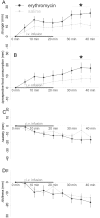The motilin agonist erythromycin increases hunger by modulating homeostatic and hedonic brain circuits in healthy women: a randomized, placebo-controlled study
- PMID: 29379095
- PMCID: PMC5789052
- DOI: 10.1038/s41598-018-19444-5
The motilin agonist erythromycin increases hunger by modulating homeostatic and hedonic brain circuits in healthy women: a randomized, placebo-controlled study
Abstract
The motilin agonist, erythromycin, induces gastric phase III of the migrating motor complex, which in turn generates hunger peaks. To identify the brain mechanisms underlying these orexigenic effects, 14 healthy women participated in a randomized, placebo-controlled crossover study. Functional magnetic resonance brain images were acquired for 50 minutes interprandially. Intravenous infusion of erythromycin (40 mg) or saline started 10 minutes after the start of scanning. Blood samples (for glucose and hormone levels) and hunger ratings were collected at fixed timepoints. Thirteen volunteers completed the study, without any adverse events. Brain regions involved in homeostatic and hedonic control of appetite and food intake responded to erythromycin, including pregenual anterior cingulate cortex, anterior insula cortex, orbitofrontal cortex, amygdala, caudate, pallidum and putamen bilaterally, right accumbens, hypothalamus, and midbrain. Octanoylated ghrelin levels decreased, whereas both glucose and insulin increased after erythromycin. Hunger were higher after erythromycin, and these differences covaried with the brain response in most of the abovementioned regions. The motilin agonist erythromycin increases hunger by modulating neurocircuitry related to homeostatic and hedonic control of appetite and feeding. These results confirm recent behavioural findings identifying motilin as a key orexigenic hormone in humans, and identify the brain mechanisms underlying its effect.
Conflict of interest statement
The authors declare that they have no competing interests.
Figures





Similar articles
-
Intragastric quinine administration decreases hedonic eating in healthy women through peptide-mediated gut-brain signaling mechanisms.Nutr Neurosci. 2019 Dec;22(12):850-862. doi: 10.1080/1028415X.2018.1457841. Epub 2018 Apr 2. Nutr Neurosci. 2019. PMID: 29607741 Clinical Trial.
-
Motilin-induced gastric contractions signal hunger in man.Gut. 2016 Feb;65(2):214-24. doi: 10.1136/gutjnl-2014-308472. Epub 2014 Dec 24. Gut. 2016. PMID: 25539673
-
The motilin receptor agonist erythromycin stimulates hunger and food intake through a cholinergic pathway.Am J Clin Nutr. 2016 Mar;103(3):730-7. doi: 10.3945/ajcn.115.113456. Epub 2016 Jan 27. Am J Clin Nutr. 2016. PMID: 26817505 Clinical Trial.
-
Redefining the functional roles of the gastrointestinal migrating motor complex and motilin in small bacterial overgrowth and hunger signaling.Am J Physiol Gastrointest Liver Physiol. 2016 Feb 15;310(4):G228-33. doi: 10.1152/ajpgi.00212.2015. Epub 2015 Dec 10. Am J Physiol Gastrointest Liver Physiol. 2016. PMID: 26660537 Review.
-
[Treatment of radiotherapy-induced gastroparesis with erythromycin].Dtsch Med Wochenschr. 1996 Mar 29;121(13):402-5. doi: 10.1055/s-2007-1023931. Dtsch Med Wochenschr. 1996. PMID: 8681733 Review. German.
Cited by
-
Motilin and its receptor are expressed in the dorsal horn in a rat model of acute incisional pain: Intrathecal motilin injection alleviates pain behaviors.Front Neurosci. 2023 Feb 2;17:1104862. doi: 10.3389/fnins.2023.1104862. eCollection 2023. Front Neurosci. 2023. PMID: 36816129 Free PMC article.
-
The Acute Effect of Hydroxychloroquine Sulfate on Hunger, the Plasma Concentration of Orexigenic Peptides and Hedonic Food Intake: A Pilot Study.Nutrients. 2023 Oct 5;15(19):4264. doi: 10.3390/nu15194264. Nutrients. 2023. PMID: 37836548 Free PMC article. Clinical Trial.
-
Satiety does not alter the ventral striatum's response to immediate reward in bulimia nervosa.J Abnorm Psychol. 2021 Nov;130(8):862-874. doi: 10.1037/abn0000712. J Abnorm Psychol. 2021. PMID: 34843290 Free PMC article.
-
Brain activation after nasal histamine provocation in house dust mite allergic rhinitis patients.Allergy. 2021 Jun;76(6):1879-1882. doi: 10.1111/all.14677. Epub 2020 Dec 12. Allergy. 2021. PMID: 33283291 Free PMC article. No abstract available.
-
The gastrointestinal tract in hunger and satiety signalling.United European Gastroenterol J. 2021 Jul;9(6):727-734. doi: 10.1002/ueg2.12097. Epub 2021 Jun 21. United European Gastroenterol J. 2021. PMID: 34153172 Free PMC article. Review.
References
Publication types
MeSH terms
Substances
LinkOut - more resources
Full Text Sources
Other Literature Sources

